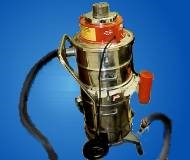Hospitals eTool
Hospital-wide Hazards » Mercury
Hazard
Employee exposure to mercury from accidental spills that can occur with broken mercury thermometers or sphygmomanometers, or during sterilization and centrifugation of thermometers in maintenance areas. Mercury can also be found in some pressure-sensing instruments (e.g., barometers and sensors in machine rooms), as well as electronic equipment, and some older medical devices.
When mercury is exposed to the air, as in the case of a spill, it slowly vaporizes. If spills are not promptly cleaned up, mercury may accumulate on surfaces and then vaporize and be inhaled by unaware workers. Mercury can also be absorbed through the skin.
Health Effects

- Elemental mercury and methylmercury are toxic to the central and peripheral nervous systems. The inhalation of mercury vapor can produce harmful effects on the nervous, digestive and immune systems, lungs, and kidneys, and may be fatal. The inorganic salts of mercury are corrosive to the skin, eyes and gastrointestinal tract, and may induce kidney toxicity if ingested (WHO).
- Neurological and behavioral disorders may be observed after inhalation, ingestion or dermal exposure of different mercury compounds. Symptoms include tremors, insomnia, memory loss, neuromuscular effects, headaches, and cognitive and motor dysfunction. Mild, subclinical signs of central nervous system toxicity can be seen in workers exposed to an elemental mercury level in the air of 20 μg/m3 or more for several years. Kidney effects have been reported, ranging from increased protein in the urine to kidney failure. (WHO).
Regulatory Requirements
- OSHA’s Hazard Communication Standard, 29 CFR 1910.1200. Employers are required to ensure that employees are aware of the hazards associated with the chemicals to which they are exposed in the workplace and on the precautions to properly protect themselves.
- Dispose of mercury spills according to U.S. Environmental Protection Agency (EPA) regulations. [See, for example, 40 CFR 261.24, which defines mercury as hazardous solid waste]
- Employers must provide, ensure the use of, and maintain appropriate personal protective equipment (PPE) for clean-up of spills. [29 CFR Part 1910 Subpart I]
- No employee is allowed to consume food or beverages in any area exposed to a toxic material. [29 CFR 1910.141(g)(2)]
Recognized Controls and Work Practices

- Prevent mercury spills by replacing outdated glass thermometers and sphygmomanometers with mercury-free devices.
- Use mercury spill kits to help clean up small spills of 25ml or less. Ensure that kits contain gloves, protective glasses, Hg absorb powder, mercury sponges, and a disposal bag.
- Establish procedures to isolate the contaminated area.
- Be aware that mercury can unknowingly be carried home on clothing, skin, or hair.
- Recognize that mercury may be present in various instruments and equipment.
- Ensure that only trained workers clean up spills promptly. Do not allow workers WHO are not properly trained to clean up spills.
- Ensure that workers use special mercury vacuum cleaners and water-soluble mercury decontaminant to clean up spills.
- Ensure that workers use disposable protective equipment, (e.g., protective gloves and footwear, special mercury vapor respirators, gowns, and hoods), while cleaning up mercury spills.
- Avoid using carpeting or porous surfaces on floors that would make clean-up difficult.
- Clearly post warnings at and around all spill areas until adequate clean-up has been accomplished.
- Use a Mercury Vapor Analyzer to verify that a spill area is safe to reenter.
- Medically monitor the respiratory tract, nervous system, kidneys, and skin of any worker WHO may be exposed to mercury.

Additional Information
- Inorganic Mercury and its Compounds. OSHA Directive CPL 02-02-006, (October 30, 1978).
- Mercury in Your Environment. U.S. Environmental Protection Agency (EPA).
- Mercury and Health. World Health Organization (WHO).
- Toxic Substances Portal – Mercury. Agency for Toxic Substances and Disease Registry (ATSDR).
- Occupational Health Guidelines for Chemical Hazard. U.S. Department of Health and Human Services (DHHS), National Institute for Occupational Safety and Health (NIOSH) Publication No. 81-123, (January 1981). Provides a table of contents of guidelines for many hazardous chemicals. The files provide technical chemical information, including chemical and physical properties, health effects, exposure limits, and recommendations for medical monitoring, personal protective equipment (PPE), and control procedures.
- Guidelines for Protecting the Safety and Health of Health Care Workers. U.S. Department of Health and Human Services (DHHS), National Institute for Occupational Safety and Health (NIOSH) Publication No. 88-119, (1988).
- Mercury. OSHA Safety and Health Topics page.

